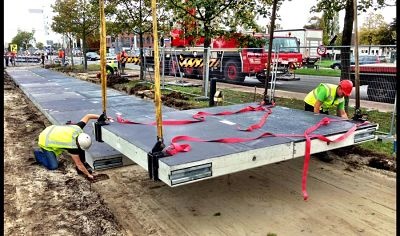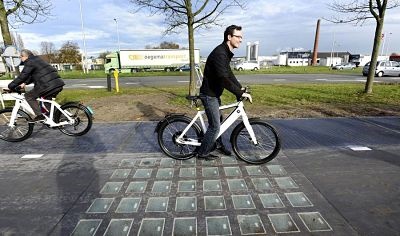Sten de Wit, Senior Advisor, TNO, discusses SolaRoad at TEDxBinnenhof, 2015
When we think of photovoltaics (PV), many of us picture rooftop solar panels that convert solar energy into an electrical current. However, a pilot project initiated in the Netherlands in November 2014, is changing the way that we envision the future applications of solar technology in society. Dutch company SolaRoad installed the world’s first energy-generating solar bike path in the town of Krommenie, outside of Amsterdam.
The 70-metre long solar road is made out of ordinary solar panels embedded in concrete slabs. The panels are protected by a centimetre-thick layer of transparent, tempered glass that is coated in a rough plastic substance to prevent slippage on the smooth surface. The road can support bikes and vehicles up to 12 metric tonnes, meaning that it can support the average American car, which weighs about 2 tonnes. Future models of the solar road would have to be further developed to support heavier vehicles like transport trucks or buses.

The results from the SolaRoad’s first round of testing have exceeded expectations. According to initial findings, each square metre of SolaRoad generates approximately 50-70 kilowatt hours of energy per year. As of December 2015, the 70-metre test track generated 9,700 kilowatt hours of electricity, which is enough energy to power three households for a year.
There exists the potential to expand the power-generating area of the SolaRoad in the Netherlands, given that there are 35,000 kilometres of designated bike paths alone. Reports suggest that up to 20% of the Netherlands’ roads can be effectively adapted into SolaRoad.
Unlike rooftop solar panels, which are limited in potential surface area and which have to be connected to the power grid individually, each kilometre-long segment of these solar-powered roadways can be easily linked together and connected to the grid at strategic locations. Solar roads are dual purpose in that unlike power plants, they do not take up additional land space and can produce local energy nearer to energy users themselves. This is would allow optimal land use for countries like the Netherlands, which is already densely populated and highly farmed. According to SolaRoad spokesman Dr. Sten de Wit, as reported in Tech.mic, one day these roads could also power sensors “that improve traffic management, or even allow automatic vehicle guidance.”

The $3.7 million price tag on the three-year pilot project is being covered by the local government in the province of North Holland, as well as a number of Dutch companies with a stake in the commercialization of solar roads. Project analysts are confident that although the pilot project is a high-cost endeavour, successive projects have the potential to become profitable within a decade, as solar cell production becomes cheaper and more efficient. This means installation and maintenance become the greatest expenses, and are already being improved upon in subsequent versions.
Dr. Sten de Wit explains that as the technology continues to be perfected, the aim is to develop a solar road with the same 20-25-year life expectancy as rooftop solar panels. In the long run, he believes that solar roads will become a cheaper option than standard roads. The amount of energy yielded during a solar road’s lifetime creates a payback period that compensates for the higher initial investment.
Evidence demonstrates that there is still room for improvement when it comes to solar road technology, however. Roads cannot be angled towards the sun in the same way that rooftop panels can, so solar roads currently receive approximately 30% less solar power as a result. Improved versions of anti-slip coating are also in the works to address peeling and breakage that have occurred as a result of sun exposure and temperature changes throughout the test run.
The seemingly promising results of studies on the SolaRoad have inspired other countries around the world, including the United States, to work on their own versions of solar roads and parking lots, but high costs remain a significant barrier to wide scale deployment of the emerging technologies.
It seems that only time will tell if solar roads will become standard societal fixtures in the future. What do you think?
Sources: CBC News – Technology and Science & Tech.Mic





